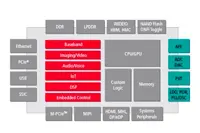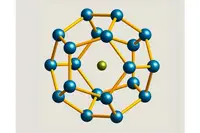Electronics News
Archive : 19 March 2015 год
 The Engineering and Physical Sciences Research Council (EPSRC) and Innovate UK are making a £5million investment, enhanced by £9m core funding from Queen's University Belfast, to boost the development of the Centre for Secure Information Technologies (CSIT) to create what they expect to be a leading hub for cybersecurity research and innovation for Smart Cities and the Internet of Things.
The Engineering and Physical Sciences Research Council (EPSRC) and Innovate UK are making a £5million investment, enhanced by £9m core funding from Queen's University Belfast, to boost the development of the Centre for Secure Information Technologies (CSIT) to create what they expect to be a leading hub for cybersecurity research and innovation for Smart Cities and the Internet of Things.
CSIT – part of Queen's Institute for Electronics, Communications and Information Technology (ECIT) – will use this investment to drive forward its own research programmes, support the creation of more businesses and jobs and provide skills and training for the UK cyber security industry. It will allow the creation of a nine-month pre-accelerator programme for cyber security entrepreneurs, as well as supporting 25 additional staff across engineering, research and commercial disciplines.
Kevin Baughan, director of technology and innovation at Innovate UK, said CSIT has delivered significant UK economic growth through the original joint investment with EPSRC, contributing to more than 950 new jobs in the Belfast cyber security cluster. "By extending funding for a further five years, we underline our support for their commitment to raise the commercialisation bar even higher. This will help companies of all sizes grow through leveraging the excellent UK science base in cyber security."
Since CSIT was established six years ago, it has developed technologies for secure machine to machine authentication, a novel mobile biometric authentication solution and algorithms for detecting anomalies in complex networks.
CSIT's Professor John McCanny said: "This further investment in CSIT recognises how, over the last five years, we have successfully blended world class research and innovation to deliver economic impact nationally, internationally and regionally. This funding will allow us to further accelerate new value creation in this sector, drive business venture creation and build capacity for the industry by providing it with high calibre Masters and PhD graduates."
Author
Graham Pitcher
Source: www.newelectronics.co.uk
 Cadence and ARM have signed what has been described as a 'broad IP interoperability agreement'; a multiyear deal which allows each company to access relevant IP portfolios from the other. The two companies will also be allowed to manufacture test chips containing the other's IP and to provide development platforms to customers.
Cadence and ARM have signed what has been described as a 'broad IP interoperability agreement'; a multiyear deal which allows each company to access relevant IP portfolios from the other. The two companies will also be allowed to manufacture test chips containing the other's IP and to provide development platforms to customers.
The agreement covers existing and future Cortex processors, Mali GPUs, CoreLink system IP and Artisan physical IP, as well as Cadence Design IP, such as cores for PCI Express, Ethernet, analogue and memory and storage protocols.
Craig Cochran, vp of marketing with Cadence, said: "Customers will be assured that they will be using IP that has been proven to work. It will also allow Cadence to optimise IP performance and to reduce the risk to the customer. To our knowledge, this is the first broad IP interoperability agreement in the industry."
Pete Hutton, president of ARM's product groups, added: "Extending our collaboration with Cadence to IP interoperability means we are mutually embracing the increasing importance of optimising the IP systems within SoC designs. By working together closely, we can continue to deliver the key technologies that allow our customers to push the boundaries of innovation."
Keven Yee, product marketing director for Cadence's IP group, said: "This allows us to access and cross license IP to support customers with system level integration. SoCs are becoming more complex and the number of IP blocks being integrated continues to increase. Someone looking to integrate a Cortex-M processor core with analogue functionality will know that we have made sure the integration works smoothly."
Author
Graham Pitcher
Source: www.newelectronics.co.uk
 Chemists from Goethe University have synthesised a compound featuring 20 silicon atoms in a dodecahedron. According to the team, the development opens up new perspectives for the semiconductor industry.
Chemists from Goethe University have synthesised a compound featuring 20 silicon atoms in a dodecahedron. According to the team, the development opens up new perspectives for the semiconductor industry.
The Si20 dodecahedron is roughly as large as the C60 molecule – or Buckyball – discovered in 1985. However, while the carbon atoms in C60 form double bonds, the atoms in the silicon dodecahedron are connected through single bonds and this, says the team, means it is related to dodecahedrane (C20H20). "In its day, dodecahedrane was viewed as the 'Mount Everest' of organic chemistry because it initially could only be synthesised through a 23 step sequence. In contrast, our Si20 cage can be created in one step starting from Si2 building blocks," said Professor Matthias Wagner.
The Si20 hollow bodies are always filled with a chloride ion. On its surface, the cluster carries eight Cl atoms and 12 Cl3Si groups. In the future, the researchers are planning to use the surface bound Cl3Si anchor groups to produce three dimensional nanonetworks out of Si20 units.
According to Prof Wagner: "Spatially strictly limited silicon nanoparticles display fundamentally different properties to conventional silicon wafers." Access to siladodecahedrane is therefore said to open up the possibility of studying the fundamental electronic properties of cage like Si nanoparticles.
Author
Graham Pitcher
Source: www.newelectronics.co.uk

